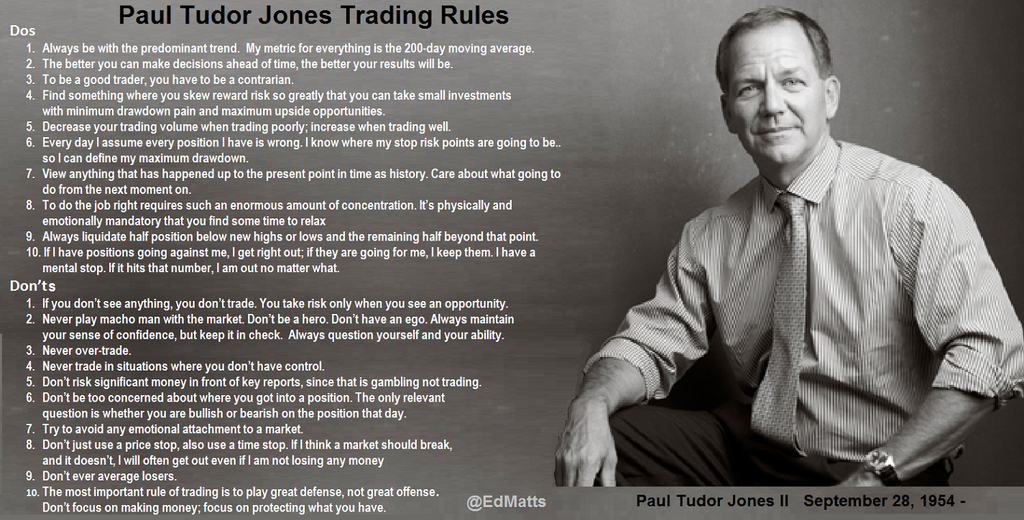To begin with, I recommend that you follow these trading rules from Paul Tudor Jones:
After analysing all of my previous trades, I came up with the following set of trading rules to help me avoid making the same mistakes again and to maximise my profits.
Essentially the only way to stop making the same set of mistakes is to entirely replace your bad trading habits with new ones, and to set up a set of rules that can be easily followed to achieve consistent trading success.
Additionally, you need to realise that one way to improve your trading performance is to start doing the opposite of what you’ve been doing so far. So where do I begin …
Well my most expensive trading mistakes were taking poor trades in the first place, some of them were impulsive trades and clearly not well thought out or planned in terms of entry, target, and stop loss.
RULE # 1 – Only place well planned trades
Plan out each trade so you know exactly when to get into a trade, why you’re placing that trade, what the risk is in terms of points or money, and where you’re hoping to take a profit.
The trading criteria itself doesn’t need to be complicated, and in the past it’s been something that I’ve spent far too much time agonising over – thinking there was some magical trading formula that I was missing and needed to discover. Very simply, your trading criteria can be as simple as the next 5 minute candle closing on the other side of the 20 minute moving average, or the market bouncing off a previous level of support.
Secondly, some of my biggest losing days were when I tried to chase the market and doubled or trebled up in an attempt to salvage a losing trade. After making a bad trade I would take out additional trades in order to average down my position, and in the majority of cases, those trades ended up as huge losers.
RULE # 2 – Never add to losing trades
The best loss is the first loss, so accept the loss and thank yourself that you didn’t lose any more money. Looking at my trading stats, there were a couple of losing days that turned out to be massive losers, and in hindsight, if I had just taken the first loss without placing additional trades, I would have saved myself a small fortune.
My third main mistake was snatching at profits instead of letting my profits run. I would quickly close out a position after making a measly 5 or 10 points instead of having the confidence to leave the position intact for a little longer. This is the fear of losing coming into play…
RULE # 3 – Move stops to breakeven to establish a risk free trading opportunity
The real idea here is to protect your stake and not to let a winning trade turn into a losing one. When in profit, fight the urge to close the position immediately and instead, move the stops to breakeven. This way no matter what happens, you’re not going to lose any money. For additional safety, you could also close out half your position at this stage, and allow the remainder to run.
My next mistake was getting stopped out too frequently and on a number of occasions the market would stop me out and immediately proceed in the direction of my trade. So either my timing was incorrect, rushing into trades, or the stop loss was inadequate. I think I have a way to address this mistake …
RULE # 4 – Trade small but use a larger stop loss
Instead of opening up relatively large positions with very tight stops (some trades taken with just a 10 point stop), open up a smaller position with a 20 or 30 point stop loss. This allows the trade to develop and gives you some breathing space to allow the market to get back into profit at some stage. When it does, follow rule # 3 immediately.
My last main trading error has been not having the confidence to add to winning trades. Obviously, when you’ve had a string of losing trades, your natural instinct is to grab a profit when the next trade seems to be going your way. But picking up a couple of points is not going to make you rich, especially when immediately afterwards, the market shoots in the direction of your intended trade, leaving you to sit there shaking your head in disbelief having missed out on a 100 point move.
RULE # 5 – Add to winning trades on retracements
The rationale behind this rule is to try and take the opposite action of what an unsuccessful trader with bad habits would do.
Instead of adding to losing trades, only add to winning trades on the next significant retracement – say after the market pulls back to one third or a half of the last high, or alternatively, track the market along the line of a significant moving average and periodically open up additional trades in the same direction as the first trade when the market drops back to touch the MA. Trying to perfect adding to existing trades takes a lot of confidence and a certain amount of experience. Not an easy rule to master so tread carefully.
Try and implement these five trading rules the next time you trade and hopefully they’ll help you avoid some common mistakes while making your trading a profitable experience.

